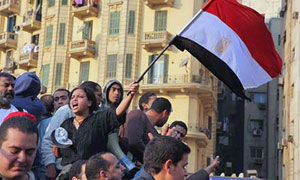Egyptian protests intensify, challenge 30 years of pro-U.S. dictatorship
By
John Catalinotto
Published Jan 27, 2011 10:19 PM
Tens of thousands of people have taken to the streets in cities across Egypt
demanding the ouster of U.S. ally President Hosni Mubarak. These are the
largest anti-regime protests in Mubarak’s 30-year rule of this North
African country of 85 million people. Though the White House has declared the
Mubarak regime “stable,” even greater protests are expected on Jan.
28 following Friday services at mosques throughout the country.
Egyptian opposition forces were inspired by the uprising in nearby Tunisia,
which on Jan. 14 forced that country’s dictator, Zine El Abadine Ben Ali,
to flee to Saudi Arabia. The uprising in Tunisia surprised not only its own
rulers but their imperialist overlords in Paris and Washington.
The smallest of the North African countries, Tunisia’s worldwide role has
been limited. The Egyptian regime, on the other hand, is the lynchpin of U.S.
foreign policy in the Arab world.
U.S. diplomacy in the region and its support for the Israeli settler state has
also depended on Egyptian compliance and cooperation. Thus a collapse of the
Mubarak-led dictatorship in Egypt brought about by a mass popular uprising
could have an enormous impact on imperialist and Israeli policy in the entire
region.
In Egypt, a coalition of opposition groups — including the Karama, the
April 6th Movement, the National Association for Change, the Popular Democratic
Movement for Change, the Justice and Freedom Youth Movement and the
Revolutionary Socialists — had called for national demonstrations against
the Mubarak regime on Jan. 25. The regime celebrates this day as “Law
Day,” but the opposition called it a “Day of Anger.”
Usually anti-government protests in Egypt consist-s of a few hundred people,
bravely defying double that number of quite brutal police. On Jan. 25, tens of
thousands came out in Cairo and other thousands in Alexandria, Suez and many
other Egyptian cities.
Police repressive, people fight back
The next day tens of thousands more came out to continue the protests. Their
demands include that Mubarak leave, that his son Gamal Mubarak — who was
expected to be named his successor — retire from politics, and for
freedom, justice and a democratic regime. Egypt has between 5,000 and 10,000
political prisoners. The regime arrested another 1,200 demonstrators by late on
Jan. 26, according to independent attorneys.
Most reports described an afternoon with demonstrators dodging water cannons,
tear gas and police batons. The British Guardian’s Cairo correspondent
Jack Shenker — who was rounded up with a group of protesters —
brought out to the world what Egyptian protesters already knew. He graphically
described how people were beaten and mistreated and nearly killed while trucked
away toward the desert.
Then on Jan. 27, the police opened up with plastic bullets and live ammunition.
In the town of Sheik Suwajed in the Sinai Peninsula, a Bedouin was killed.
Overcoming the fear that a brutal system depends on to stay in power, the
people came back even stronger.
In Suez City that morning, demonstrators set the local police headquarters on
fire. In addition to raising political demands, families from all over gathered
to demand that their relatives, imprisoned for up to three days, be
released.
Official reports said that six people died during the first three days of
demonstrations, two of them police. Hundreds more demonstrators were
injured.
Role of the U.S.
Washington supplies $2 billion in aid yearly to Egypt, most of it military aid.
It had Egyptian support in 1991 for the first assault on and invasion of Iraq.
Israel counts on Egypt to police the southern border of Gaza, under blockade
for the past four years.
Washington has supported Mubarak for decades. Now it is faced with the choice
of backing his regime to the end or trying to arrange for a transition to a new
government that is also dependent on imperialist support and would basically
continue the same policies. This means a pro-imperialist and pro-U.S. foreign
policy and neo-liberal economic policies inside Egypt.
In situations that had some similarities in the past — for example, the
Philippines and Haiti in 1986, Zaire and Indonesia in the 1990s — U.S.
imperialism was able to achieve both. It has supported dictatorships until
their rule became untenable and then shifted its support to the opposition,
helping to arrange the transition. If the change involved having opposition
leader Mohamed ElBaradei and his group replace Mubarak, that would likely be a
change Washington could live with.
Statements by U.S. President Barack Obama and Secretary of State Hillary Rodham
Clinton have called for political reforms in Egypt but have also asked both the
government and the protesters to refrain from violence. The government has a
virtual monopoly on violence. Its tanks, tear gas and ammunition all come from
the United States. But if the tens of millions of Egyptians who live on less
than $2 a day join the protests of the political opposition, these weapons
won’t be enough to save the regime.
To show solidarity with the Egyptian protesters, people are invited to join a
demonstration on Sat., Jan. 29, from 1-3 p.m. at the United Nations in New
York City at First Avenue and 47th Street.
Articles copyright 1995-2012 Workers World.
Verbatim copying and distribution of this entire article is permitted in any medium without royalty provided this notice is preserved.
Workers World, 55 W. 17 St., NY, NY 10011
Email:
ww@workers.org
Subscribe
wwnews-subscribe@workersworld.net
Support independent news
DONATE


